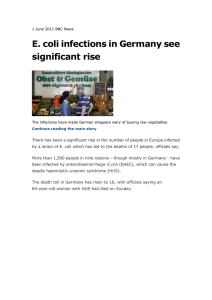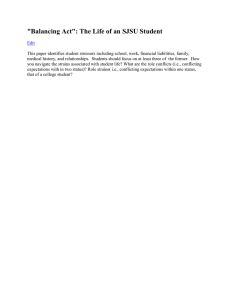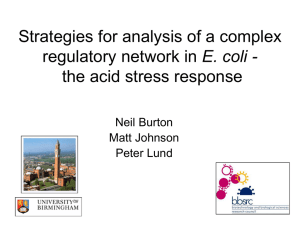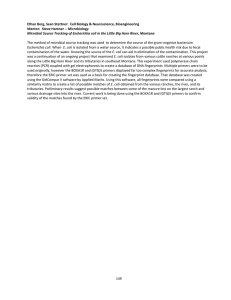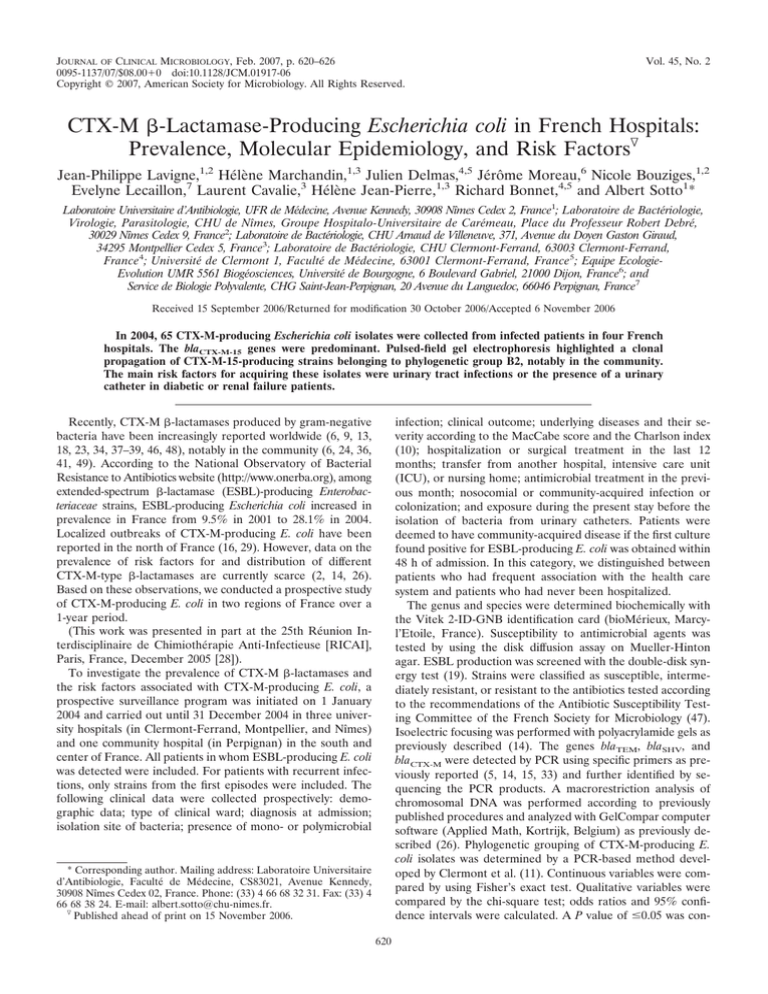
JOURNAL OF CLINICAL MICROBIOLOGY, Feb. 2007, p. 620–626
0095-1137/07/$08.00⫹0 doi:10.1128/JCM.01917-06
Copyright © 2007, American Society for Microbiology. All Rights Reserved.
Vol. 45, No. 2
CTX-M -Lactamase-Producing Escherichia coli in French Hospitals:
Prevalence, Molecular Epidemiology, and Risk Factors䌤
Jean-Philippe Lavigne,1,2 Hélène Marchandin,1,3 Julien Delmas,4,5 Jérôme Moreau,6 Nicole Bouziges,1,2
Evelyne Lecaillon,7 Laurent Cavalie,3 Hélène Jean-Pierre,1,3 Richard Bonnet,4,5 and Albert Sotto1*
Laboratoire Universitaire d’Antibiologie, UFR de Médecine, Avenue Kennedy, 30908 Nı̂mes Cedex 2, France1; Laboratoire de Bactériologie,
Virologie, Parasitologie, CHU de Nı̂mes, Groupe Hospitalo-Universitaire de Carémeau, Place du Professeur Robert Debré,
30029 Nı̂mes Cedex 9, France2; Laboratoire de Bactériologie, CHU Arnaud de Villeneuve, 371, Avenue du Doyen Gaston Giraud,
34295 Montpellier Cedex 5, France3; Laboratoire de Bactériologie, CHU Clermont-Ferrand, 63003 Clermont-Ferrand,
France4; Université de Clermont 1, Faculté de Médecine, 63001 Clermont-Ferrand, France5; Equipe EcologieEvolution UMR 5561 Biogéosciences, Université de Bourgogne, 6 Boulevard Gabriel, 21000 Dijon, France6; and
Service de Biologie Polyvalente, CHG Saint-Jean-Perpignan, 20 Avenue du Languedoc, 66046 Perpignan, France7
Received 15 September 2006/Returned for modification 30 October 2006/Accepted 6 November 2006
In 2004, 65 CTX-M-producing Escherichia coli isolates were collected from infected patients in four French
hospitals. The blaCTX-M-15 genes were predominant. Pulsed-field gel electrophoresis highlighted a clonal
propagation of CTX-M-15-producing strains belonging to phylogenetic group B2, notably in the community.
The main risk factors for acquiring these isolates were urinary tract infections or the presence of a urinary
catheter in diabetic or renal failure patients.
Recently, CTX-M -lactamases produced by gram-negative
bacteria have been increasingly reported worldwide (6, 9, 13,
18, 23, 34, 37–39, 46, 48), notably in the community (6, 24, 36,
41, 49). According to the National Observatory of Bacterial
Resistance to Antibiotics website (http://www.onerba.org), among
extended-spectrum -lactamase (ESBL)-producing Enterobacteriaceae strains, ESBL-producing Escherichia coli increased in
prevalence in France from 9.5% in 2001 to 28.1% in 2004.
Localized outbreaks of CTX-M-producing E. coli have been
reported in the north of France (16, 29). However, data on the
prevalence of risk factors for and distribution of different
CTX-M-type -lactamases are currently scarce (2, 14, 26).
Based on these observations, we conducted a prospective study
of CTX-M-producing E. coli in two regions of France over a
1-year period.
(This work was presented in part at the 25th Réunion Interdisciplinaire de Chimiothérapie Anti-Infectieuse [RICAI],
Paris, France, December 2005 [28]).
To investigate the prevalence of CTX-M -lactamases and
the risk factors associated with CTX-M-producing E. coli, a
prospective surveillance program was initiated on 1 January
2004 and carried out until 31 December 2004 in three university hospitals (in Clermont-Ferrand, Montpellier, and Nı̂mes)
and one community hospital (in Perpignan) in the south and
center of France. All patients in whom ESBL-producing E. coli
was detected were included. For patients with recurrent infections, only strains from the first episodes were included. The
following clinical data were collected prospectively: demographic data; type of clinical ward; diagnosis at admission;
isolation site of bacteria; presence of mono- or polymicrobial
infection; clinical outcome; underlying diseases and their severity according to the MacCabe score and the Charlson index
(10); hospitalization or surgical treatment in the last 12
months; transfer from another hospital, intensive care unit
(ICU), or nursing home; antimicrobial treatment in the previous month; nosocomial or community-acquired infection or
colonization; and exposure during the present stay before the
isolation of bacteria from urinary catheters. Patients were
deemed to have community-acquired disease if the first culture
found positive for ESBL-producing E. coli was obtained within
48 h of admission. In this category, we distinguished between
patients who had frequent association with the health care
system and patients who had never been hospitalized.
The genus and species were determined biochemically with
the Vitek 2-ID-GNB identification card (bioMérieux, Marcyl’Etoile, France). Susceptibility to antimicrobial agents was
tested by using the disk diffusion assay on Mueller-Hinton
agar. ESBL production was screened with the double-disk synergy test (19). Strains were classified as susceptible, intermediately resistant, or resistant to the antibiotics tested according
to the recommendations of the Antibiotic Susceptibility Testing Committee of the French Society for Microbiology (47).
Isoelectric focusing was performed with polyacrylamide gels as
previously described (14). The genes blaTEM, blaSHV, and
blaCTX-M were detected by PCR using specific primers as previously reported (5, 14, 15, 33) and further identified by sequencing the PCR products. A macrorestriction analysis of
chromosomal DNA was performed according to previously
published procedures and analyzed with GelCompar computer
software (Applied Math, Kortrijk, Belgium) as previously described (26). Phylogenetic grouping of CTX-M-producing E.
coli isolates was determined by a PCR-based method developed by Clermont et al. (11). Continuous variables were compared by using Fisher’s exact test. Qualitative variables were
compared by the chi-square test; odds ratios and 95% confidence intervals were calculated. A P value of ⱕ0.05 was con-
* Corresponding author. Mailing address: Laboratoire Universitaire
d’Antibiologie, Faculté de Médecine, CS83021, Avenue Kennedy,
30908 Nı̂mes Cedex 02, France. Phone: (33) 4 66 68 32 31. Fax: (33) 4
66 68 38 24. E-mail: albert.sotto@chu-nimes.fr.
䌤
Published ahead of print on 15 November 2006.
620
VOL. 45, 2007
NOTES
621
TABLE 1. Distribution of ESBL-producing Escherichia coli strains described in four French hospitals
Hospital (no. of beds)
No. of strains
(n ⫽ 112)
Prevalence (%) of
strains producing:
a
ESBLs
CTX-M
b
CTX-M types produced
(no. of strains 关n ⫽ 65兴)
Other ESBL types produced
(no. of strains 关n ⫽ 47兴)
Montpellier (2,923)
71
2.40
1.39
CTX-M-15 (24), CTX-M-14 (8),
CTX-M-1 (7), CTX-M-2 (1),
CTX-M-27 (1)
TEM-24 (15), TEM-3 (4), TEM-15 (1),
TEM-19 (1), TEM-21 (1), TEM-106 (1),
SHV-5 (5) SHV-2 (1), SHV-4 (1)
Nı̂mes (1,700)
19
0.81
0.34
CTX-M-15 (5), CTX-M-1 (2),
CTX-M-14 (1)
TEM-24 (6), TEM-3 (2), TEM-19 (1),
TEM-52 (1), TEM-129 (1)
Clermont-Ferrand (2,068)
12
0.35
0.29
CTX-M-15 (5), CTX-M-1 (3),
CTX-M-14 (2)
TEM-24 (2)
Perpignan (922)
10
1.13
0.68
CTX-M-15 (3), CTX-M-14 (2),
CTX-M-1 (1)
TEM-24 (3), SHV-2 (1)
a
b
The number of ESBL-producing E. coli strains divided by the number of total E. coli strains.
The number of CTX-M-producing E. coli strains divided by the number of total E. coli isolates.
sidered to reflect statistical significance. Logistic regression
was performed to determine the variables and interactions that
were significantly associated with the risk of infection with
CTX-M-producing E. coli. Variables were selected in a stepwise backward process (30). All statistical tests were performed
using JMP software (version 3.2.2; SAS Institute, Inc.).
During the study period, 112 ESBL-producing E. coli strains
were isolated from 111 patients. The prevalence of ESBL production among the E. coli isolates was ⬍3% (Table 1). The
prevalence of CTX-M-producing E. coli among the total number of E. coli isolates was 0.68%, and the occurrence of CTXM-producing E. coli among ESBL-producing E. coli isolates
was 58%. The distribution of the different types of ESBLs
recovered during this study according to the geographical origin of the corresponding strains is shown in Table 1. CTXM-15 was the most prevalent CTX-M type produced in our
study (Table 1). Among CTX-M-producing strains, two isolates (strains MECA13 and PEC2) were resistant to cefoxitin (MIC between 64 and 128 g/ml), and four strains
(MECT, MECB5072, CF1110, and CF1229) were intermediate to cefoxitin (MIC between 8 and 32 g/ml). All isolates
were susceptible to imipenem. Resistance was observed with
tobramycin (63.1%), gentamicin (52.3%), amikacin (27.7%),
co-trimoxazole (72.3%), and tetracyclines (66.2%). Of the
CTX-M-producing E. coli isolates, 73.8% were resistant to
quinolones (nalidixic acid) versus 51.1% of the TEM- and
SHV-producing E. coli isolates (P ⬍ 0.01). Similarly, 66.2% of
CTX-M-producing isolates were resistant to ciprofloxacin versus 42.6% of the TEM- and SHV-producing isolates (P ⬍
0.01).
Pulsed-field gel electrophoresis revealed a high level of
genomic diversity for both TEM-type and SHV-type ESBLproducing E. coli isolates. No identical pulsotypes were observed for CTX-M-producing isolates except for those producing CTX-M-15. Indeed, pulsed-field gel electrophoresis
revealed three different groups of closely related restriction
patterns among these CTX-M-15-producing isolates. The most
important group was found in Montpellier Hospital (cluster CI,
19 isolates). Two others were found in Nı̂mes Hospital (cluster
CII, four strains) and in Perpignan Hospital (cluster CIII, two
strains) (Fig. 1). Twenty-two strains belonging to the three
clusters were isolated from urinary samples (CI, 16/19 strains;
CII, 4/4 strains; CIII, 2/2 strains). Twelve strains had a community origin (CI, 11/19 strains; CII, 0/4 strains; CIII, 1/2 strains).
Five patients infected with these strains were associated with
the health care system (CI, 4/19 patients; CII, 0/4 patients; CIII,
1/2 patients), and seven patients had never been hospitalized
(CI, 7/19 patients; CII, 0/4 patients; CIII, 0/2 patients). No
clustering of patients could be demonstrated. The clonal isolates harbored similar ESBL-encoding plasmids, and these
plasmids yielded similar restriction patterns after digestion
with HindIII (27).
The majority of E. coli strains were isolated from urinary
tract specimens (64 strains, 57.1%), most notably CTX-Mproducing isolates (44 strains, 67.7%). Among these isolates
analyzed, phylogenetic group B2, which is the source of most
uropathogenic E. coli clones (12), included 45.5% of the strains
(2.3% were subgroup B22, and 43.2% were subgroup B23).
Phylogenetic group D, which is also but to a lesser extent a
source of uropathogenic E. coli, included 36.4% of the strains
(31.9% were subgroup D1, and 4.5% were subgroup D2). Phylogenetic groups A and B1 represented 13.6% (4.5% were
subgroup A0, and 9.1% were subgroup A1) and 4.5% of the
strains, respectively. The strains comprising Montpellier cluster CI and Nı̂mes cluster CII belonged to the B2 group. The two
isolates of Perpignan cluster CIII belonged to the D1 group.
A univariate analysis comparing patients with CTX-M-producing E. coli isolates and patients with E. coli isolates producing other ESBLs is shown in Table 2. CTX-M-producing E.
coli isolates were involved mainly in infections (colonization/
infection rate, 0.23), especially with urinary tract infections
(UTIs) (67.8%). Of the patients with UTIs, 43.8% had received antibiotic therapy in the last month. Interestingly, 22 of
65 CTX-M-producing bacteria had community origins (P ⬍
0.01). The multivariate analysis selected diabetes mellitus, renal disease, UTI, gynecological surgery, and the presence of a
urinary catheter as independent factors associated with an
increased risk of isolation of CTX-M-producing E. coli (P ⬍
0.01) (Table 3). Moreover, a high proportion of these infections had a community origin (P ⬍ 0.01). When only patients
infected with a CTX-M-producing clone were considered, the
risk factors identified by multivariate analysis were cardiovas-
622
NOTES
J. CLIN. MICROBIOL.
FIG. 1. Dendrogram of XbaI-digested genomic DNAs and phylogenetic groups of all CTX-M-15-producing E. coli isolates from four hospitals
in France. Strains were clustered with the unweighted-pair group method using average linkages. The scale indicates the percentage of genetic
similarity.
cular disease, urinary incontinence, the presence of a urinary
catheter, and polymicrobial infection (P ⬍ 0.01) (Table 3).
This report documents the recent increase in ESBL-producing E. coli in France (to a prevalence of 28.1%, as reported by
the National Observatory of Bacterial Resistance to Antibiotics) and, for the first time, the important role of CTX-Mproducing strains in this evolution. However, we noted a geographic imbalance in the rates of CTX-M producers (Table 1),
probably due to the heterogenous populations among the
different hospitals. These CTX-M-producing strains have
emerged and spread in most parts of the world (6, 9, 13, 18, 23,
34, 37–39, 46, 48). During this period, the proportion of
CTX-M strains among ESBL-producing E. coli isolates has
dramatically increased from 38.2% to 87% (8, 38, 41, 43, 44,
46). The CTX-M-15 enzyme seems to be the most common, as
previously described (3, 8, 17, 22, 25, 26, 29, 31, 34, 38). Length
of hospital stay, severity of illness, time in the intensive care
unit, intubation and mechanical ventilation, urinary or arterial
catheterization, and previous exposure to antibiotics have been
described as the main risk factors associated with acquiring
ESBL-producing strains (4). In this study, other risk factors
were associated with CTX-M-producing E. coli infection, like
renal disease, diabetes mellitus, and surgery of the genitourinary tract. Usually, infections caused by ESBL-producing E.
coli have a nosocomial origin. We observed that, in comparison
with strains producing other ESBLs (6.4%) as noted previously
(2, 40, 41, 43, 45, 49), 33.8% of the CTX-M-producing strains
were isolated in outpatients. Among the 22 outpatients infected by CTX-M-producing E. coli, 5 had been hospitalized
during the last year, one of the main risk factors for CTX-M-lactamase acquisition in the outpatients (45). This study revealed a highly diverse population structure of ESBL-producing strains, with only 25 clonally related CTX-M-15-producing
strains grouped in three unrelated clusters. Among these 25
clonal strains, only one cross-contamination could be identified
in a medicine ward of Montpellier University Hospital. Data
VOL. 45, 2007
NOTES
623
TABLE 2. Univariate analysis of potential risk factors associated with the isolation of CTX-M-producing E. coli
Characteristicb
Value for E. coli isolates producing:a
CTX-M
No. of strains
65
47
Age, median yr
72
72
27/37
26/21
Male/female
Sex ratio
0.73
OR (95% CI)d
P value
—
—
—
—
TEM or SHV
1.24
Comorbid disease/condition
Charlson index
Cardiovascular diseases
Myocardial infarction
Heart failure
Renal disease
Diabetes mellitus
COPD
Hematologic or solid malignancy
Neutropenia
HIV
Immunosuppressor
Solid organ transplant
Hepatic diseases
Cirrhosis
Peptic ulcer
Alcoholism
Neurological disease
Cerebrovascular accident
Hemiplegia
Urinary incontinence
Dementia
Autoimmune diseases
Bedridden
4.1 [0–10]
28 (43.8)
5 (7.8)
7 (10.9)
25 (39.1)
29 (45.3)
14 (21.9)
16 (25.0)
10 (15.6)
1 (1.6)
13 (20.3)
4 (6.3)
8 (12.5)
5 (7.8)
1 (1.6)
5 (7.8)
7 (10.9)
4 (6.3)
6 (9.4)
12 (18.8)
7 (10.9)
1 (1.6)
6 (9.4)
3.4 [0–11]
23 (48.9)
4 (8.5)
6 (12.8)
5 (10.6)
7 (14.9)
11 (23.4)
9 (19.1)
5 (10.6)
(0)
6 (12.8)
(0)
3 (6.4)
2 (4.3)
4 (8.5)
2 (4.3)
3 (6.4)
5 (10.6)
13 (27.7)
11 (23.4)
7 (14.9)
2 (4.3)
11 (23.4)
—
—
—
—
5.1 (2.4–12.0)
3.4 (1.7–7.0)
—
—
—
—
—
0.0 (0.0–1.21)
—
—
—
—
—
—
0.3 (0.1–0.9)
—
—
—
0.3 (0.1–1.1)
MacCabe scores
0
1
2
24 (37.4)
28 (43.8)
12 (18.8)
25 (53.2)
16 (34.0)
6 (12.8)
—
—
—
12 (18.8)
12/53 (0.23)
33/22 (1.5)
3
20
6 (12.8)
19/28 (0.68)
44/3 (14.6)
5
22
—
3.0 (1.5–6.2)
0.1 (0.1–0.3)
—
—
—
0.001
⬍0.0001
—
—
Wards
Medicine
Surgery
ICU
Geriatric
Recovery
Emergency
25 (39.1)
12 (18.8)
17 (26.5)
2 (3.1)
2 (3.1)
6 (9.4)
12 (25.5)
11 (23.4)
12 (25.5)
5 (10.6)
6 (12.8)
1 (2.2)
—
—
—
—
0.2 (0.0–1.3)
—
—
—
—
—
0.06
—
Presence of:
Urinary catheter
Mechanical ventilation
Tracheotomy
Parenteral nutrition
Central venous catheter
26 (40.6)
5 (7.8)
(0)
7 (10.9)
16 (25.0)
12 (25.5)
7 (14.9)
8 (17.0)
3 (6.4)
9 (19.1)
2.7 (1.1–7.0)
—
0.0 (0–0.2)
—
—
0.02
—
⬍0.0001
—
—
Sources
Urinary c
Cutaneous
Bloodc
Respiratory tract
44 (67.8)
1 (1.5)
2 (3.1)
3 (4.6)
20 (42.6)
10 (21.3)
2 (4.3)
2 (4.3)
2.6 (1.4–4.8)
0.2 (0.1–0.6)
—
—
0.002
⬍0.0001
—
—
Mortality rate
Colonization/infection
Nosocomial/community origin
Acquisition delay (days)
Hospitalization delay (days)
0.01
—
—
—
⬍0.001
⬍0.001
—
—
—
—
—
0.03
—
—
—
—
—
—
0.02
—
—
—
0.06
—
—
—
Continued on following page
624
NOTES
J. CLIN. MICROBIOL.
TABLE 2—Continued
Value for E. coli isolates producing:a
Characteristicb
CTX-M
Pus
Catheter
Bonec
OR (95% CI)d
P value
TEM or SHV
14 (21.5)
1 (1.5)
(0)
12 (25.5)
(0)
1 (2.1)
—
—
—
—
—
—
Antecedents
Hospitalization ⬍1 yr
ICU ⬍1 yr
Transfer from another hospital
Surgery
Gynecologic
Urologic
40 (62.5)
20 (31.3)
23 (35.9)
20 (31.3)
7 (10.9)
12 (18.5)
30 (63.8)
18 (38.3)
15 (31.9)
13 (27.7)
(0)
3 (6.4)
—
—
—
—
2.1 (0.0–5.2)
—
—
—
—
—
0.002
—
Prior antibiotic therapy ⬍1 mo
Fluoroquinolones
-Lactams
B-S cephalosporins
Carbapenems
28 (43.8)
14 (21.9)
17 (26.6)
8 (12.5)
2 (3.1)
18 (38.3)
3 (6.4)
14 (29.8)
6 (12.8)
3 (6.4)
—
—
—
—
—
—
—
—
—
—
Polymicrobial infections
Enterococcus spp.
Candida spp.
Proteus mirabilis
21 (32.3)
12 (18.5)
4 (6.2)
(0)
14 (29.8)
5 (10.6)
—
—
—
—
—
—
—
—
3 (6.4)
a
Values in parentheses indicate interquartile ranges or percentages.
All characteristics except number of strains, age, sex ratio, Charlson index, MacCabe scores, and mortality data are given in number (%) of patients. COPD, chronic
obstructive pulmonary disease; HIV, human immunodeficiency virus; ICU, intensive care unit; B-S, broad-spectrum.
c
Factors associated exclusively with infections.
d
OR, odds ratio; CI, confidence interval; —, not significant.
b
collected for the remaining isolates suggested that the clonal
dissemination of CTX-M-15-producing strains is not associated with the spread of the strains in the hospital, since no
relationships between patients (temporal, geographical, or
other association) have been found. Moreover, seven unrelated patients hospitalized at the Montpellier Hospital ac-
TABLE 3. Multivariate analysis of risk factors associated with
increased risk of acquisition of ESBL-producing E. coli
Patient group and risk factor
ORa
P value
Patients with CTX-M-producing
E. coli
Renal disease
Diabetes mellitus
Urinary tract infection
Community-acquired infection
Surgery
Gynecological surgery
Urinary catheter
8.4
5.2
17.9
26.7
7.1
6.9
4.1
0.0037
0.0231
0.0030
⬍0.0001
0.0281
0.0087
0.0437
5.9
8.9
5.3
5.4
0.0153
0.0028
0.0211
0.0205
16.2
23.3
14.8
0.0064
⬍0.0001
0.0001
Patients with clonal CTX-Mproducing E. coli
Cardiovascular disease
Urinary incontinence
Urinary catheter
Polymicrobial infection
Patients with other ESBLproducing E. coli
Cutaneous samples
Nosocomial infection
Tracheotomy
a
OR, odds ratio.
quired clonally related CTX-M-15-producing E. coli from the
community. No seasonal variation was found in our study. The
sparse dissemination of these bacteria suggested a probable
food or water source, the source most common to all the
outpatients, as previously suggested (1, 35). Patients with urinary tract diseases or foreign materials (e.g., infection, catheter, or incontinence) more frequently developed infections
with clonally CTX-M-producing E. coli, even in the presence of
a small number of patients (n ⫽ 25). Finally, these data showed
the emergence of three different clones of CTX-M-15-producing E. coli strains, including strains of probable community
origin, contrasting with previous reports describing localized,
nosocomial outbreaks (16, 17, 29, 32, 46, 49).
The majority of CTX-M-producing strains recovered during
this study were isolated from UTIs. The phylogenetic distribution showed a majority of strains in non-B2 phylogenetic
groups (24/44 strains), as previously reported (7), except for
CTX-M-15 strains, which belonged mainly to the B2 group
(20/30 strains), as recently described (42). Branger et al. demonstrated that E. coli strains belonging to non-B2 phylogenetic
groups have a greater incidence of antimicrobial resistance,
express significantly fewer virulence factors, and more frequently invade compromised hosts (7). In this study, the population described was frequently immunocompromised by a
particular alteration of the urinary tract, the main risk factor
identified by the multivariate analysis (20, 21, 42). The frequency of CTX-M strains in weakened patients and the incidence of these strains in the community invite further study of
the epidemiologic evolution of these strains and dissemination
of this information to the medical community.
VOL. 45, 2007
NOTES
We are very grateful to A. Gouby for help in this work and to
Josiane Campos for her technical assistance.
This work was supported by Université de Montpellier 1 (BQR, BQ
68, and BQ 88), La ville de Nı̂mes, and La Région Languedoc-Roussillon.
20.
REFERENCES
21.
1. Altekruse, S. F., D. L. Swerdlow, and S. J. Wells. 1998. Factors in the
emergence of food borne diseases. Vet. Clin. N. Am. Food Anim. Pract.
14:1–15.
2. Arpin, C., V. Dubois, L. Coulange, C. André, I. Fischer, P. Noury, F. Grobost,
J.-P. Brochet, J. Jullin, B. Dutilh, G. Larribet, I. Lagrange, and C. Quentin.
2003. Extended-spectrum -lactamase-producing Enterobacteriaceae in community and private health care centers. Antimicrob. Agents Chemother.
47:3506–3514.
3. Baraniak, A., J. Fiett, A. Sulikowska, W. Hryniewicz, and M. Gniadkowski.
2002. Countrywide spread of CTX-M-3 extended-spectrum -lactamaseproducing microorganisms of the family Enterobacteriaceae in Poland. Antimicrob. Agents Chemother. 46:151–159.
4. Bhavnani, S. M., P. G. Ambrose, W. A. Craig, M. N. Dudley, R. N. Jones, and
SENTRY Antimicrobial Surveillance Program. 2006. Outcomes evaluation
of patients with ESBL- and non-ESBL-producing Escherichia coli and Klebsiella species as defined by CLSI reference methods: report from the SENTRY
Antimicrobial Surveillance Program. Diagn. Microbiol. Infect. Dis. 54:231–
236.
5. Bonnet, R., C. Dutour, J. L. M. Sampaio, C. Chanal, D. Sirot, R. Labia, C.
De Champs, and J. Sirot. 2001. Novel cefotaximase (CTX-M-16) with increased catalytic efficiency due to substitution Asp-2403Gly. Antimicrob.
Agents Chemother. 45:2269–2275.
6. Bonnet, R. 2004. Growing group of extended-spectrum -lactamases: the
CTX-M enzymes. Antimicrob. Agents Chemother. 48:1–14.
7. Branger, C., O. Zamfir, S. Geoffroy, G. Laurans, G. Arlet, H. V. Thien, S.
Gouriou, B. Picard, and E. Denamur. 2005. Genetic background of Escherichia coli and extended-spectrum -lactamase type. Emerg. Infect. Dis.
11:54–61.
8. Brigante, G., F. Luzzaro, M. Perilli, G. Lombardi, A. Coli, G. M. Rossolini,
G. Amicosante, and A. Toniolo. 2005. Evolution of CTX-M-type beta-lactamases in isolates of Escherichia coli infecting hospital and community patients. Int. J. Antimicrob. Agents 25:157–162.
9. Chanawong, A., F. H. M’Zali, J. Heritage, J.-H. Xiong, and P. M. Hawkey.
2002. Three cefotaximases, CTX-M-9, CTX-M-13, and CTX-M-14, among
Enterobacteriaceae in the People’s Republic of China. Antimicrob. Agents
Chemother. 46:630–637.
10. Charlson, M. E., P. Pompei, K. L. Ales, and C. R. MacKenzie. 1987. A new
method of classifying prognostic comorbidity in longitudinal studies: development and validation. J. Chronic Dis. 40:373–383.
11. Clermont, O., S. Bonacorsi, and E. Bingen. 2000. Rapid and simple determination of the Escherichia coli phylogenetic group. Appl. Environ. Microbiol. 66:4555–4558.
12. Culham, D. E., and J. M. Wood. 2000. An Escherichia coli reference collection group B2- and uropathogen-associated polymorphism in the rpoS-mutS
region of the E. coli chromosome. J. Bacteriol. 182:6272–6276.
13. De Champs, C., D. Sirot, C. Chanal, R. Bonnet, J. Sirot, and the French
Study Group. 2000. A 1998 survey of extended-spectrum -lactamases in
Enterobacteriaceae in France. Antimicrob. Agents Chemother. 44:3177–3179.
14. De Champs, C., C. Chanal, D. Sirot, R. Baraduc, J. P. Romaszko, R. Bonnet,
A. Plaidy, M. Boyer, E. Carroy, M. C. Gbadamassi, S. Laluque, O. Oules,
M. C. Poupart, M. Villemain, and J. Sirot. 2004. Frequency and diversity of
class A extended-spectrum beta-lactamases in hospitals of the Auvergne,
France: a 2 year prospective study. J. Antimicrob. Chemother. 54:634–639.
15. Dutour, C., R. Bonnet, H. Marchandin, M. Boyer, C. Chanal, D. Sirot, and
J. Sirot. 2002. CTX-M-1, CTX-M-3, and CTX-M-14 -lactamases from
Enterobacteriaceae isolated in France. Antimicrob. Agents Chemother. 46:
534–537.
16. Eckert, C., V. Gautier, M. Saladin-Allard, N. Hidri, C. Verdet, Z. OuldHocine, G. Barnaud, F. Delisle, A. Rossier, T. Lambert, A. Philippon, and G.
Arlet. 2004. Dissemination of CTX-M-type -lactamases among clinical isolates of Enterobacteriaceae in Paris, France. Antimicrob. Agents Chemother.
48:1249–1255.
17. Edelstein, M., M. Pimkin, I. Palagin, I. Edelstein, and L. Stratchounski.
2003. Prevalence and molecular epidemiology of CTX-M extended-spectrum
-lactamase-producing Escherichia coli and Klebsiella pneumoniae in Russian
hospitals. Antimicrob. Agents Chemother. 47:3724–3732.
18. Hernández, J. R., L. Martı́nez-Martı́nez, R. Cantón, T. M. Coque, A. Pascual,
and the Spanish Group for Nosocomial Infections (GEIH). 2005. Nationwide study of Escherichia coli and Klebsiella pneumoniae producing extended-spectrum -lactamases in Spain. Antimicrob. Agents Chemother. 49:
2122–2125.
19. Jarlier, V., M. H. Nicolas, G. Fournier, and A. Philippon. 1988. Extended
broad-spectrum -lactamases conferring transferable resistance to newer
22.
23.
24.
25.
26.
27.
28.
29.
30.
31.
32.
33.
34.
35.
36.
37.
38.
39.
40.
41.
625
-lactam agents in Enterobacteriaceae: hospital prevalence and susceptibility
patterns. Rev. Infect. Dis. 10:867–878.
Johnson, J. R., P. Goullet, B. Picard, S. L. Moseley, P. L. Roberts, and W. E.
Stamm. 1991. Association of carboxylesterase B electrophoretic pattern with
presence and expression of urovirulence factor determinants and antimicrobial resistance among strains of Escherichia coli that cause urosepsis. Infect.
Immun. 59:2311–2315.
Johnson, J. R., F. Scheutz, P. Ulleryd, M. A. Kuskowski, T. T. O’Bryan, and
T. Sandberg. 2005. Host-pathogen relationships among Escherichia coli isolates recovered from men with febrile urinary tract infection. Clin. Infect.
Dis. 40:813–822.
Karim, A., L. Poirel, S. Nagarajan, and P. Nordmann. 2001. Plasmid-mediated extended-spectrum beta-lactamase (CTX-M-3 like) from India and
gene association with insertion sequence ISEcp1. FEMS Microbiol. Lett.
201:237–241.
Kim, J., Y.-M. Lim, Y.-S. Jeong, and S.-Y. Seol. 2005. Occurrence of CTXM-3, CTX-M-15, CTX-M-14, and CTX-M-9 extended-spectrum -lactamases in Enterobacteriaceae clinical isolates in Korea. Antimicrob. Agents Chemother. 49:1572–1575.
Knox, J. R. 1995. Extended-spectrum and inhibitor-resistant TEM-type
-lactamases: mutations, specificity, and three-dimensional structure. Antimicrob. Agents Chemother. 39:2593–2601.
Lartigue, M. F., L. Poirel, C. Heritier, V. Tolun, and P. Nordmann. 2003.
First description of CTX-M-15-producing Klebsiella pneumoniae in Turkey.
J. Antimicrob. Chemother. 52:315–316.
Lavigne, J.-P., N. Bouziges, C. Chanal, A. Mahamat, S. Michaux-Charachon, and A. Sotto. 2004. Molecular epidemiology of Enterobacteriaceae isolates producing extended-spectrum -lactamases in a French hospital.
J. Clin. Microbiol. 42:3805–3808.
Lavigne, J.-P., H. Marchandin, J. Delmas, N. Bouziges, E. Lecaillon, L.
Cavalie, H. Jean-Pierre, R. Bonnet, and A. Sotto 2006. qnrA in CTX-Mproducing Escherichia coli isolates from France. Antimicrob. Agents Chemother. 50:4224–4228.
Lavigne, J.-P., H. Marchandin, J. Delmas, J. Moreau, N. Bouziges, E. Lecaillon, L. Cavalie, H. Jean-Pierre, R. Bonnet, and A. Sotto. 2005. Abstr. 25th
Reun. Interdis. Chimi. Anti-Infect. (RICAI), abstr. 222/520.
Leflon-Guibout, V., C. Jurand, S. Bonacorsi, F. Espinasse, M. C. Guelfi, F.
Duportail, B. Heym, E. Bingen, and M.-H. Nicolas-Chanoine. 2004. Emergence and spread of three clonally related virulent isolates of CTX-M-15producing Escherichia coli with variable resistance to aminoglycosides and
tetracycline in a French geriatric hospital. Antimicrob. Agents Chemother.
48:3736–3742.
Legendre, P., and L. Legendre. 1998. Numerical ecology: developments in
environmental modelling, 2nd English ed. Elsevier, Amsterdam, The Netherlands.
Livermore, D. M., and P. M. Hawkey. 2005. CTX-M: changing the face of
ESBLs in the UK. J. Antimicrob. Chemother. 56:451–454.
Ma, L., Y. Ishii, F.-Y. Chang, K. Yamaguchi, M. Ho, and L. K. Siu. 2002.
CTX-M-14, a plasmid-mediated CTX-M type extended-spectrum -lactamase isolated from Escherichia coli. Antimicrob. Agents Chemother. 46:
1985–1988.
Mabilat, C., S. Goussard, W. Sougakoff, R. C. Spencer, and P. Courvalin.
1990. Direct sequencing of the amplified structural gene and promoter for
the extended-broad-spectrum beta-lactamase TEM-9 (RHH-1) of Klebsiella
pneumoniae. Plasmid 23:27–34.
Markovska, R., I. Schneider, E. Keuleyan, and A. Bauernfeind. 2004. Extended-spectrum beta-lactamase (ESBL) CTX-M-15-producing Escherichia
coli and Klebsiella pneumoniae in Sofia, Bulgaria. Clin. Microbiol. Infect.
10:752–755.
Mead, P. S., L. Slutsker, V. Dietz, L. F. McCaig, J. S. Bresee, C. Shapiro,
P. M. Griffin, and R. V. Tauxe. 1999. Food-related illness and death in the
United States. Emerg. Infect. Dis. 5:607–625.
Medeiros, A. A. 1997. Evolution and dissemination of -lactamases accelerated by generations of -lactam antibiotics. Clin. Infect. Dis. 24:S19–S45.
Moland, E. S., J. A. Black, A. Hossain, N. D. Hanson, K. S. Thomson, and
S. Pottumarthy. 2003. Discovery of CTX-M-like extended-spectrum -lactamases in Escherichia coli isolates from five U.S. States. Antimicrob. Agents
Chemother. 47:2382–2383.
Moubareck, C., Z. Daoud, N. I. Hakimé, M. Hamzé, N. Mangeney, H. Matta,
J. E. Mokhbat, R. Rohban, D. K. Sarkis, and F. Doucet-Populaire. 2005.
Countrywide spread of community- and hospital-acquired extended-spectrum -lactamase (CTX-M-15)-producing Enterobacteriaceae in Lebanon.
J. Clin. Microbiol. 43:3309–3313.
Mugnaioli, C., F. Luzzaro, F. De Luca, G. Brigante, M. Perilli, G. Amicosante, S. Stefani, A. Toniolo, and G. M. Rossolini. 2006. CTX-M-type extended-spectrum -lactamases in Italy: molecular epidemiology of an emerging countrywide problem. Antimicrob. Agents Chemother. 50:2700–2706.
Munday, C. J., J. Xiong, C. Li, D. Shen, and P. M. Hawkey. 2004. Dissemination of CTX-M type beta-lactamases in Enterobacteriaceae isolates in the
People’s Republic of China. Int. J. Antimicrob. Agents 23:175–180.
Pitout, J. D. D., D. B. Gregson, D. L. Church, S. Elsayed, and K. B. Laupland. 2005. Community-wide outbreaks of clonally related CTX-M-14 -lac-
626
42.
43.
44.
45.
46.
NOTES
tamase-producing Escherichia coli strains in the Calgary health region.
J. Clin. Microbiol. 43:2844–2849.
Pitout, J. D. D., K. B. Laupland, D. L. Church, M. L. Menard, and J. R.
Johnson. 2005. Virulence factors of Escherichia coli isolates that produce
CTX-M-type extended-spectrum -lactamases. Antimicrob. Agents Chemother. 49:4667–4670.
Pournaras, S., A. Ikonomidis, D. Sofianou, A. Tsakris, and A. N. Maniatis.
2004. CTX-M-type beta-lactamases affect community Escherichia coli treatment, Greece. Emerg. Infect. Dis. 10:1163–1164.
Quinteros, M., M. Radice, N. Gardella, M. M. Rodriguez, N. Costa, D.
Korbenfeld, E. Couto, G. Gutkind, and the Microbiology Study Group. 2003.
Extended-spectrum -lactamases in Enterobacteriaceae in Buenos Aires, Argentina, public hospitals. Antimicrob. Agents Chemother. 47:2864–2867.
Rodrı́guez-Baño, J., M. D. Navarro, L. Romero, L. Martı́nez-Martı́nez, M. A.
Muniain, E. J. Perea, R. Pérez-Cano, and A. Pascual. 2004. Epidemiology
and clinical features of infections caused by extended-spectrum beta-lactamase-producing Escherichia coli in nonhospitalized patients. J. Clin. Microbiol.
42:1089–1094.
Romero, L., L. Lopez, J. Rodriguez-Bano, J. Ramon Hernandez, L. Martinez-
J. CLIN. MICROBIOL.
Martinez, and A. Pascual. 2005. Long-term study of the frequency of Escherichia coli and Klebsiella pneumoniae isolates producing extended-spectrum
beta-lactamases. Clin. Microbiol. Infect. 11:625–631.
47. Soussy, C. J., G. Carret, J. D. Cavallo, and the Antibiotic Susceptibility
Testing Committee of the French Society for Microbiology. Accessed January 2006. Report of the Antibiotic Susceptibility Testing Committee of the
French Society for Microbiology. January 2005, posting date. http://www.sfm
.asso.fr.
48. Spanu, T., F. Luzzaro, M. Perilli, G. Amicosante, A. Toniolo, G. Fadda, and
the Italian ESBL Study Group. 2002. Occurrence of extended-spectrum
-lactamases in members of the family Enterobacteriaceae in Italy: implications for resistance to -lactams and other antimicrobial drugs. Antimicrob.
Agents Chemother. 46:196–202.
49. Woodford, N., M. E. Ward, M. E. Kaufmann, J. Turton, E. J. Fagan, D.
James, A. P. Johnson, R. Pike, M. Warner, T. Cheasty, A. Pearson, S. Harry,
J. B. Leach, A. Loughrey, J. A. Lowes, R. E. Warren, and D. M. Livermore.
2004. Community and hospital spread of Escherichia coli producing CTX-M
extended-spectrum beta-lactamases in the UK. J. Antimicrob. Chemother.
54:735–743.



